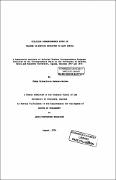Utilizing correspondence study in teacher in service education in East Africa: a comparative analysis of selected teacher correspondence programs conducted by the correspondence units at the University of Nairobi, Kenya and Makerere University, Uganda, between 1967 and 1973
Abstract
The overall purpose of the study was to generate more information about
training and retraining primary teachers in East Africa by
correspondence. Four primary teacher correspondence programs were studied.
(1) Grade I Teachers Upgrading Program (Uganda);
(2) Licensed Teachers ' Training Program (Uganda);
(3) P3 Teachers' Program (Kenya) ;
(4) UQT (Unqualified Teachers ' Program) (Kenya).
The firs t two programs were conducted by t he Correspondence Unit at
Makerere University, and the last two by the Correspondence Course Unit
at the University of Nairobi.
The objectives of the study were to indicate the major differences
and similarities among t he programs, t o assess the teacher-respondents'
evaluations of the programs, and to make suggestions for future primary
teacher correspondence programs in East Africa .
Data were collected in 197 5 through documentary research, interviews,
conversations , letters, and questionnaires sent t o a total of 400 teachers
(i . e . 100 teachers in each program).
The comparative approach was selected for the purpose of making the
study more analytical l than would have been the case if each of the programs
was described separately . The Bereday- Rosello comparative approach was
used in the analysis and comparison.
The programs had much in common . They were. initiated by the Ministries
of education in Kenya and Uganda and supported by foreign technical
assistance. The broad goals of the programs were to improve the academic

